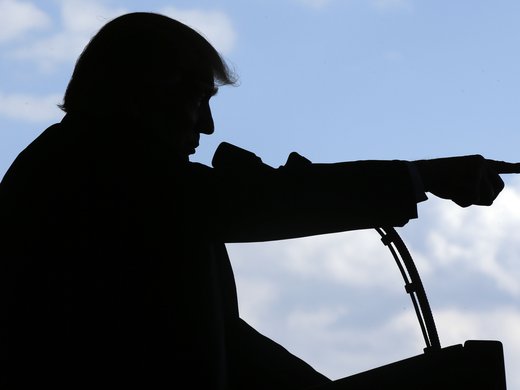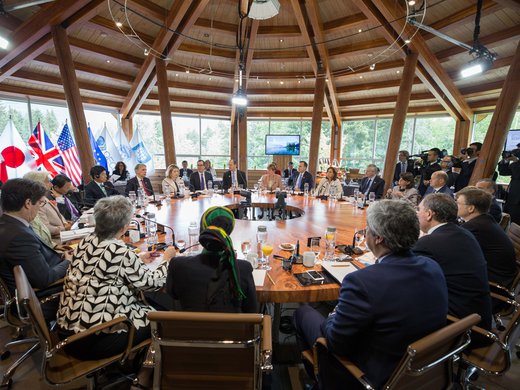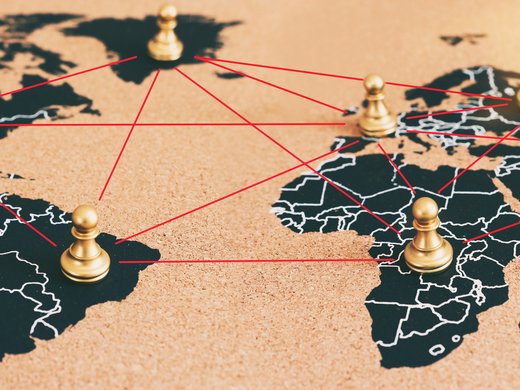Later this week, leaders from the world’s most powerful democracies will meet in the scenic region of Charlevoix, Quebec, set between the St. Lawrence River and the Laurentian Mountains, for the forty-fourth annual Group of Seven (G7) summit.
Charlevoix is spectacularly beautiful — its most celebrated summer resident, former US President William Taft, famously said its air “intoxicates like champagne.” A New York Times travel column described it as the author’s “childhood imaginings of heaven.”
In that idyllic setting, on June 8 and 9, Canadian Prime Minister Justin Trudeau will host his counterparts from the United States, the United Kingdom, Germany, France, Italy and Japan, along with the presidents of the European Council and the European Commission, at the Fairmont Le Manoir Richelieu. Located on a cliff overlooking the river, a 140 km drive from where the world’s media and civil society representatives will be gathered in Quebec City, the hotel has been chosen to provide leaders with as much of a “retreat” atmosphere as possible, where they will be free to move around and discuss the most pressing economic and political issues of the day.
Madeline Koch, the executive director of the G7 Research Group at the University of Toronto, has attended every G7 or G8 summit since 1999 (the group was known as the G8 — Group of Eight — from the time Russia was admitted in 1998 to when it was suspended in 2014). Koch says it is a “Canadian tradition” to host summits in a remote location; at the 2002 summit in Kananaskis, Alberta, she recalls, then Prime Minister Jean Chrétien’s direction to his summit management team was to never have a security person in a leader’s line of vision. For protestors, journalists or any other non-official delegates trying to get access, a secluded site is obviously not ideal. But for the leaders themselves, this set-up is invaluable.
“The G7 leaders sit around a small table, look each other in the eye, make wisecracks, interrupt each other,” Koch says. “It’s a small enough group that they can do that — they can see each other when they’re speaking, they can gauge each other’s reactions…they can have pretty frank discussions.
“The conversation isn’t going to be like a family dinner table conversation — you’ve got very different kinds of cultural styles and traditions present — but they’re still basically like-minded, it’s still a more open [discussion], they don’t speak from notes.”
For the majority of the two-day summit, the leaders won’t actually be alone. In the room with them, for the most part, will be their personal representatives or “sherpas,” who, like the Himalayan mountain guides they are named for, are responsible for blazing a trail to the summit and doing the heavy lifting in terms of preparation and organization.
Canada’s deputy minister and sherpa for this G7 summit is Peter Boehm, a long-time diplomat and former ambassador to Germany. He is the man responsible for the summit’s planning, agenda, budget, logistics and security, and reports directly to Trudeau.
Boehm — who has a small army of sous-sherpas and political directors supporting him — is the prime minister’s voice in discussions with the other G7 sherpas, the various government departments and agencies involved in Canada’s G7 presidency and the authorities on the ground in Quebec. It’s a relationship that requires a great deal of trust, a mind-meld of sorts — on Twitter, Boehm joked recently that the two are beginning to adopt the same mannerisms.
“Peter has been involved in G7 summits since the 1990s in one capacity or another, so he has a really good understanding of what’s involved,” Koch says. “He’s unusual because he’s the second-longest-serving sherpa — the other is the German sherpa. [Angela] Merkel is always teasing [Boehm] when she sees him…‘What are you still doing here?’”
Toward the Summit
In December 2017, Canada set out its five themes for this summit: investing in growth that works for everyone; preparing for jobs of the future; advancing gender equality and women’s empowerment; working together on climate change, oceans and clean energy; and building a more peaceful and secure world.
By the end of 2017, before Canada had even assumed its presidency, Boehm had visited his sherpa counterparts in every G7 capital city. Since then, he has hosted four sherpa meetings, in Waterloo, Victoria, Ottawa and Baie-Saint-Paul, and met with civil society and Indigenous groups, travelling the country to get input from Canadians young and old, in keeping with the government’s stated emphasis on transparency and consultation.
One morning last month, with 21 days to go until the summit, I spoke with Boehm over the phone from his Ottawa office. He had returned the previous night from a press conference in Quebec City and was preparing to chair a meeting of deputy ministers involved in summit preparations. I tell him the question I really want to ask is, ‘When do you sleep?’
“Of course I sleep,” he laughs. “I sleep well, because I’m exhausted at the end of the day!”
Boehm is in touch with his sherpa counterparts almost every day, he says, individually or collectively. For months, they have been negotiating the agenda of the summit, which Trudeau will moderate, as well as a draft of what they are loosely calling the “Charlevoix commitments,” related to the themes Trudeau has set out.
“So those are negotiated, and we will have some sort of a consensus document, we hope, at the end that will serve as a chapeau for all of that,” Boehm says. “Sometimes it’s called a communiqué, sometimes it’s called a chair statement or a consensus statement — we’ll see how that goes.”
While Boehm acknowledges there are issues around which the sherpas will not necessarily reach consensus, he says it is in everyone’s interest to have a good summit, “because this thing rotates — so we will pass the torch on to France next year, and of course we’ve taken it from Italy this year.
“We all know each other very well, and we also have each other’s backs, because we’re all in this together.”
Koch, who has an impressively packed summit diary herself, spoke with me over her lunch hour in Toronto in between attending the Think 7 summit, a gathering of think tank representatives, in Quebec City and flying to Berlin for a meeting of the Global Governance Project, which publishes G7 summit briefing books. She says that Canada has a long tradition of using sherpas who have had extensive involvement with the G7 and other summits over the years.
One of these, Derek Burney — a former Canadian ambassador who has held various senior government positions — likes to refer to himself as a “summit groupie.” He was Brian Mulroney’s G7 sherpa from 1990 to 1992, but his involvement stretches back to the third-ever G7 summit, in London in 1977, where he recalls newly elected US President Jimmy Carter telling him, “You know, I had to cram for this meeting almost as much as I crammed for the debates.”
Although ongoing consultations shape much of the final outcome even before the summit itself, Burney says the intensity of the leaders’ meeting brings the respective sherpas quite close together. “The environment is intimate and you don’t have a lot of time; you’re trying to pull together a communiqué together overnight after the discussion,” he describes. “You either get along with one another or you don’t, and the ones you get along with become friends for life.”
Leonard Edwards, another former Canadian ambassador, organized various summits over the course of his career, and was Stephen Harper’s sherpa from 2008 to 2010, doing double duty for both the G8 and the Group of Twenty (G20) summits in Muskoka and Toronto. “You can follow this thing all you want from the outside,” he says, “but to be part of the preparation like Peter has been, and like I was 10 years ago, sitting at that table…I’ve got stories about who said what to whom that I can never repeat.” He chuckles: “It’s fascinating.”
Burney says that ahead of the Charlevoix summit, sherpas will be “trying to get a handle on what the others are thinking, what they see as priorities, what they would like to see in the communiqué, what their leaders are going to be speaking about, what [their] domestic concerns are — all of those things.
“The better the intelligence that each of the sherpas can provide to their leaders before the meeting, the more likely you’re going to have a constructive session.”
Of course, summits are inevitably influenced — and sometimes overwhelmed — by the unpredictable (the famous line, attributed to UK Prime Minister Harold Macmillan describing what could knock his government off course — “events, dear boy, events” — came up in every conversation I had with past Canadian sherpas).
Edwards says that during every summit he has been sherpa for, a crisis came up unexpectedly, or the discussion at the leaders’ table veered off in a surprising direction. In 2010, it was the Greek sovereign debt crisis that “really threw a wrench into the works” and impacted both summits hosted by Canada.
Robert Fowler was Canada’s ambassador to Italy when, in the summer of 2001, he received a call from Chrétien, asking him to return to Canada to be his sherpa for the 2002 Kananaskis Summit. That summer, as Italy’s presidency came to a close, Africa had already been decided upon as the central theme of the summit, but Fowler couldn’t have known how much the world would change by the time Canada actually hosted.
Fowler recalls his first day in office, back in Ottawa: “It was the morning of the eleventh of September. There was a TV set in the corner; I turned it on, and the second plane rammed into the World Trade Center…The world had certainly changed.”
Burney describes world events during his time as sherpa, particularly in 1990-91, as “a matter of huge convulsion, with the collapse of the Soviet Union, the unification of Germany — events no one had foreseen.”
The failed 1991 August coup against Soviet leader Mikhail Gorbachev prompted George Bush to convene an “international telethon, as they called it, with his G7 compatriots,” Burney remembers. “Mr. Mulroney and I went to Kennebunkport, Maine, and participated with the president as he called each of the G7 leaders in order to try and determine what we should do…to respond to what was going on in Moscow.”
Charlevoix's Wild Card
All preparations aside, the wild card at the Charlevoix summit will be, of course, US President Donald Trump, whose policies and very approach to policy making seem at odds with the G7 priorities highlighted by Trudeau: gender equality, climate change, open markets and so on.
Last year’s summit in Taormina ended without a unanimous agreement on climate change, with Trump refusing to say whether or not the United States would be pulling out of the Paris climate agreement (the president announced his decision to withdraw just days later).
Last week, Trump moved to impose tariffs on steel and aluminum imports from Canada, which has contributed to a heightened sense of tension — even after months of tough talk on the North American Free Trade Agreement renegotiations — ahead of his visit to Quebec.
According to Koch, although it may feel that way to observers, a disgruntled US administration isn’t actually a huge departure from the norm. “Americans have a history of being anti-G7,” she says, a statement entirely supported by the recollections of past Canadian sherpas.
Burney considers the G7 response to the coup against Gorbachev to be “one of the high points of summitry.” Under Bush, he says, the Americans were beginning to lose their interest in summitry. “They found it a bit of a pain in the ass, quite frankly, and were wondering if it could be every two years instead of every year…but I think because of the pivotal nature of what happened with Gorbachev in 1990, the Americans got a different attitude.”
Edwards had a similar experience during his time as sherpa, recalling that in his year, “the role played by [Barack Obama’s] administration around the G8 was one of high skepticism that it really had any value.”
“I do recall at the summit meeting itself — it’s not in the history books, but it will be some day — Obama made the point that he didn’t know whether there should be a G8 next year, because the G20 was really where it was at,” Edwards says. “These were very uneasy moments. That’s why we had to make a success of it — a lot was at stake in holding both the G8 and the G20, having them both be successful and not ending up with everyone coming to the conclusion that the G8 has no role anymore.”
Burney also recalls that Ronald Reagan and Pierre Trudeau “were not exactly complementary personalities, in terms of ideology or any other thing, so there was a concern there would not be a meeting of minds” during the 1981 summit in Montebello, Quebec. But the similarities only go so far: “I think the phenomenon of Donald Trump is something that no summit has ever experienced, and goodness knows what it may or may not do for summitry this time.”
At the same time, Burney says that what Boehm has going for him is that the Charlevoix summit is taking place just a few days before Trump’s June 12 North Korea summit, which, as of June 6, still looks to be back on. “I do think that if anybody can get Trump to focus on something for more than 30 seconds, he will see the value of coming out of the summit with a unified front on the objectives that he is looking for in his summit with the North Korean leader.
“Canada and the others have to be very careful not to bait Trump, to not go out of our way to make things awkward for him. This is what you call diplomacy; this is what Peter’s biggest challenge is going to be. He can’t walk away from the fact that we have differences on some of these fundamental issues.”
Boehm has been asked many times over the past few months, including by me in December, his thoughts on the threat of a “G6 plus one” dynamic rearing its head at the summit. When we spoke in May, a week after Trump announced the United States would be pulling out of the Iran nuclear deal, his response to the question remained more or less the same: he has a great relationship with his US counterpart, and they speak frequently to try and work through any thorny issues.
“You will run into disagreements, you saw that last year in Taormina,” Boehm says. “We’ve seen it in the past, too, where the discussion on the global economy has been a fiscal stimulus-versus-austerity discussion — that did not involve the US on the austerity, that was Germany.
“So you have these discussions, and you try and work things out, and if you can’t, well, then you simply agree to disagree on something, and then you come back at it, maybe next year, or later on in other discussions.”
What G7 Success Looks Like
With enough moving parts at the summit to make anyone’s head spin, it’s tricky to qualify what would constitute a success with regards to Canada’s G7 presidency. A concrete, signature policy announcement, like the African Action Plan under Fowler, or the Muskoka Initiative on Maternal, Newborn and Child Health under Edwards? Clear and specific funding pledges? The prevention of any left-field outburst or surprise policy deviation on the part of the US president? Having the process survive another year, as Boehm (half?) jokingly quipped at an event at the University of Toronto last December?
The G7 Research Group closely tracks the G7’s commitment and compliance over the years. I asked Koch if, as others I’ve spoken with over the past few months alluded to, the focus on a range of themes instead of a concrete commitment might be viewed as a cop-out of sorts.
“If you’re asking the G7 Research Group what a marker of success is, that’s not it,” she says. “When we talk about a successful summit we talk about something much broader than one initiative. It’s based on our assessment of how well the country has negotiated their particular agenda items, the compliance aspect of it, whether they…commit funds. Those kinds of things are what we look for as a success; we’re not interested in one big item.”
Last week, Politico published an article quoting unnamed American and European sources worrying over “unprecedented division over the agenda and what joint statements might be issued out of the summit.”
But Koch says there is “a ton of stuff they’ll agree on,” noting that the United States has already pulled out of the Iran nuclear deal, so there “isn’t anything like that hanging over their heads the way there was at Taormina.”
Back in December, Boehm indicated that an agreed-upon communiqué wasn’t necessarily the be-all and end-all of summit goals: “We can negotiate communiqués until the cows come home, down to the last possible semicolon, or we can say with frankness, well, a number of countries felt this way and some others felt that way.”
Burney’s advice to Boehm is to focus on the Korea summit — the “easiest galvanizing point” — to get consensus “on [what is] perceived to be the most important issue” for Trump, which would help to build consensus around other things.
“And some of the other things, I would hope, are going to include something on trade,” Burney added. “The fact that we’re moving into a populist, protectionist kind of mode in parts of Europe and in the US, between the US and China, and between the US and almost everybody around the world…this is not good stuff. This is what summits were intended to counter.
“So the degree to which they can forge a consensus on economic issues without isolating the Americans — I think that is no small objective. I don’t envy Peter in his task, but he will be supported by virtually all the other sherpas in trying to get there.”
Ultimately, regardless of output documents, the core purpose at the heart of the G7 summit is to provide some of the world’s most powerful leaders with a space to discuss the world’s most pressing issues.
Boehm summed up what summit success would look like to him: having a good discussion and “moving the dial internationally” on the five themes Trudeau has set out.
“In the outreach session, if we can have a great conversation on oceans, move forward on a plastics initiative, to rid the oceans of plastics,” he adds, referring to the special session with non-G7 world leaders and heads of international organizations that will take place on June 9, “then I think we will have a pretty good summit, and I think it would be one that all Canadians could be proud of.”
Among the challenges for G7 and G20 summits, Koch says, is that the Canadian public “always sees dollar signs and, in the case of 2010, damage,” referring to the public demonstrations that erupted in Toronto.
She notes that the Canadian tradition is not to “spend in excess,” compared to other host countries. “Even though people may think of it as a photo op, or hot tub conversation…it’s valuable, and they can’t just look at it in pure economic terms.”
Burney stresses that the value of G7 summitry is found in the personal connections that are able to — hopefully — flourish among the leaders.
“If you think of other international organizations or events where leaders congregate — whether it’s the UN, or NATO [the North Atlantic Treaty Organization], or almost any other institution — none is as intimate as the G7. The G20 doesn’t come close; it’s too big, too amorphous.”
It’s important to keep in mind that the G7 “was never intended to be a decision-making body,” Burney adds. “It is an attempt to forge consensus and direction in addressing whatever the particular concerns of the moment are on the economic agenda — and trying to forge consensus as well on some of the more spontaneous political issues of the moment.”
Boehm and his counterparts have spent many, many months negotiating and preparing for this week, but as Edwards notes, leaders “may not have a conversation at the bloody table that has much to do with that preparation!
“But the fact is, it’s important to have that discussion, it’s important that leaders express their differences …What sherpas have to do is continue to find the relevance, so that people go away from this and then say, yes, we have to meet again next year.”
This article was first published on OpenCanada.org.



